 Migraines: Causes and 12 Natural Support Strategies
Migraines: Causes and 12 Natural Support Strategies
Chances are that you experience migraines from time to time or on a frequent basis, or you know someone who has migraines regularly. One in four US households has at least one member with migraines. Every ten seconds someone visits the emergency room with some form of a headache, in most cases, with an acute migraine attack (1).
Migraines are more than just a headache. They are characterized by severe pain and incapacitating neurological symptoms. If you have migraines, you know how important it is to find natural remedies that actually work for migraine relief and prevention. My goal is to help you tackle your migraines naturally, and live the healthy, pain-free life you deserve.
In this article, you will learn what migraines are, their types, common signs and symptoms, and their main causes. You will learn how to differentiate migraines from other types of headaches. I will also share 12 natural support strategies to reduce tension and improve circulation effectively without medication.
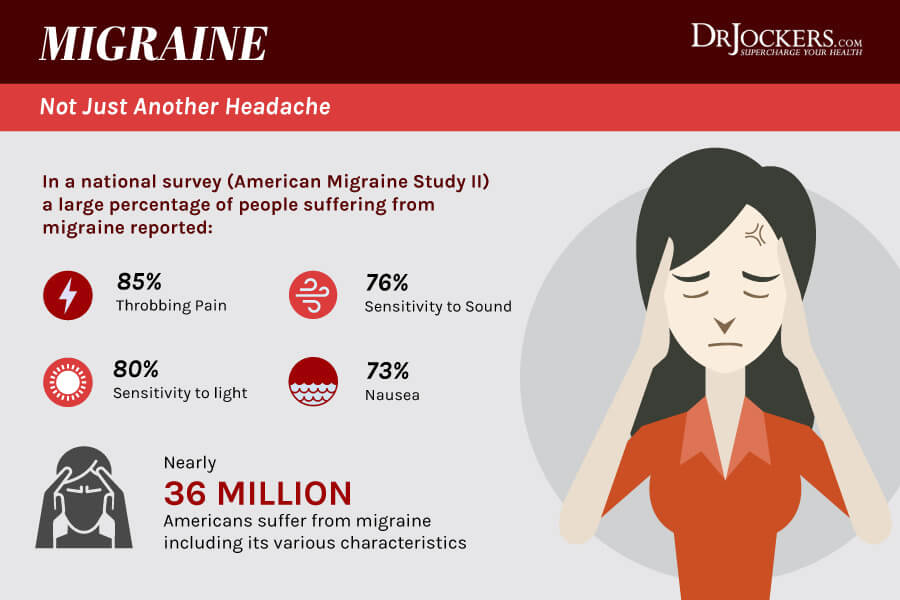
What Are Migraines
Migraines affect over 1 billion people worldwide. They affect 18 percent of women, six percent of men, and ten percent of children in the US alone. Migraines are the third most prevalent and sixth most disabling illness in the world. They often run in families. Over 4 million people in the US have chronic migraines, which means that they experience 15 or more migraine episodes a month (1).
Migraines are usually characterized by a throbbing or pulsating pain. They usually occur on only one side of the head, though some may experience it on both sides. Migraines are often accompanied by nausea, vomiting, sensitivity to smell, or sensitivity to sound. They may feel worse with exercise. Some people may experience visual disturbances called an aura before their migraine attack. Migraines may last from four to 72 hours (2).
Types of Migraines
There are a variety of forms of migraines you may experience, including the most common ones, such as migraines with and without an aura (3).
Migraines with Aura
About a quarter of people with migraines experience an aura before their migraine. An aura is a series of visual and sensory changes you may experience before a migraine, such as black dots, zigzags, bright spots, flashing lights, tingling, or numbness. An aura may last for 10 to 30 minutes before your migraine.
Migraine without Aura
Not everyone experiences an aura before their migraine. People with migraines without aura experience a similar type of pulsing or throbbing pain and other symptoms as those with an aura.
Migraine without Head Pain
Some people may experience a silent or acephalgic migraine. This type of migraine doesn’t come with head pain, instead, you may experience other alarming symptoms, such as an aura, dizziness, visual disturbances, and nausea.
Hemiplegic Migraine
This type of migraine may feel similar to a stroke. It’s characterized by a weakness of one side of the body, loss of sensation, and a ‘pins and needles’ feeling.
Retinal Migraine
Retinal migraine is characterized by a temporary vision loss in one eye often along with an aura.
Chronic Migraine
If you have 15 or more days with a migraine a month, you likely have chronic migraines. People with chronic migraines may not always experience their migraines as severe every day and may confuse them with tension or a sinus headache.

Common Signs and Symptoms
Migraine attacks are characterized by several stages: prodrome, aura, migraine attacks, and postdrome. Each stage has its own signs and symptoms. Let’s take a look at the common signs and symptoms of each stage (2, 4).
Prodrome
Before your migraine attack, you may experience the following a day or two before the actual migraine occurs:
- Constipation
- Food cravings
- Neck stiffness
- Increased thirst and urination
- Mood changes
- Frequent yawning
Aura
Some people may experience visual and sensory disturbances called an aura 20 to 60 minutes before their migraine attack.
A migraine aura may be characterized by:
- ‘Pins and needles’ sensation in the legs or arms
- Seeing black dots, bright spots, flashes of lights, and various shapes
- Vision loss
- Hearing noises
- Jerking movements
- Numbness or weakness on one side of the body or face
- Difficulty speaking
Migraine Attack
The migraine attack itself may be characterized by:
- Throbbing or pulsing pain, usually on one side of the head, but sometimes on both sides
- Sensitivity to light, sounds, and sometimes touch or smell as well
- Nausea or vomiting
Post-drome
After the migraine attack, you may feel drained or confused. Others feel ecstatic. Sudden head movement may bring about some brief pain again.

Difference Between Migraines and Other Headaches
Besides migraines, there are several other types of headaches that you should know about to understand what type of headache you are experiencing. If you are experiencing regularly, talk to an appropriate healthcare professional to see if you have migraines or another type of headache.
Once you know what kind of headaches you are dealing with, it will be easier to identify the root cause, find relief, and figure out preventative strategies (5).
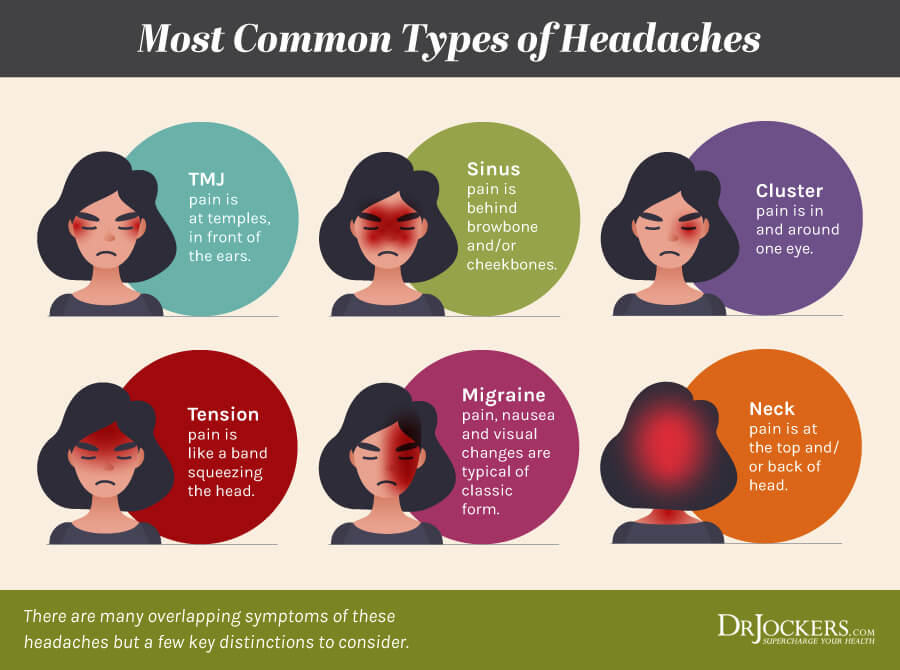
Tension Headaches
Tension headaches are one of the most common forms of headaches. They are also known as stress headaches. They are characterized by a dull pain, pressure, or tightness usually around the forehead, the back of the head, or the neck. It may feel like something is squeezing your skull. Tension headache may feel anywhere from mild to moderate.
Chronic Daily Headache
If you have headaches 15 days or more per month, you may receive the diagnosis of Chronic Daily Headaches. Chronic Daily Headaches are not a specific type of headache, instead, they refer to the frequency of the headaches. Most people with Chronic Daily Headaches experience tension-type headaches, migraines or both.
Cluster Headaches
Cluster headaches are one of the least common but also one of the most severe types of headaches. They are characterized by a burning or piercing intense pain behind the eyes. They may occur in groups within a few weeks or months.
Sinus Headaches
Sinus headaches are characterized by inflamed sinuses around the forehead, cheeks, and the bridge of your nose. They feel like pressure, and they may be occurring along with facial swelling, runny nose, ear pain, or fever.
Mixed Headache Syndrome
Mixed headache syndrome is a transformed headache that includes mixed symptoms of both migraines and tension headaches.
New Daily Persistent Headache
A new daily persistent headache is a new headache that becomes steady and persistent after 24 hours and usually occurs without a history of headaches. It may feel similar to a tension headache or migraine, but it is on-going.
Rebound Headaches
Rebound headaches occur from medication overuse. When you are taking acetaminophen, ibuprofen, aspirin, or other over-the-counter medication for pain relief, you may notice more frequent headaches, and headaches when you are not taking the medication.
Trigeminal Neuralgia
Trigeminal neuralgia (TN) is a chronic pain condition. It affects the trigeminal nerve at the back of your head which stimulates your face and results in severe headache and facial pain.

Major Causes of Migraines
There are a variety of factors that may cause migraines, including nutritional, lifestyle, and environmental factors. Let’s look at the main causes of migraines one by one.
Nutritional Deficiencies
One of the main possible root causes of migraines is nutritional deficiencies. The following nutritional deficiencies may result in migraines:
- Vitamin B2
- Folate
- Vitamin B12
- Vitamin D
- Magnesium
Dehydration
When you are sweating and getting dehydrated, your body loses essential fluids and electrolytes it needs to function optimally. When you are dehydrated, your brain can temporarily contract from fluid loss which can result in dehydration migraine, or headache. The loss of certain minerals, such as magnesium, through dehydration, may also lead to migraines.
Mold Exposure and Migraines
Mold is a serious problem in most homes in the United States that many people are completely unaware of. Mold may be lurking under your sink, in your basement, or in other parts of your house. Mold exposure in your house can lead to some uncomfortable and serious symptoms, including migraines and headaches (6).

Viral Infections and Migraines
Migraines and headaches may also be the result of a viral infection, including the Influenza virus and Rhinovirus. Migraines and headaches may also be the result of the Epstein-Barr Virus (EBV) and may also occur during or after mononucleosis (7).
Hormone Imbalance
Migraines may also occur due to hormone imbalance or hormonal fluctuation. Many women experience migraines before or during their period (8).
Bad Posture and Neck Subluxation
As a chiropractor, I must emphasize that spinal health is incredibly important for your overall health to provide structural strength and stability for your body, and to protect your nervous system. Structural misalignments, subluxations, and bad posture can result in pain in your body.
Neck subluxation, damage, stress, and irritation of the nerves often occur in the upper cervical spine due to bad posture, which is one of the most common causes of migraines and headaches.
Chronic Stress and Poor Sleep
Chronic stress and poor sleep may put your body into a cycle of fatigue and inflammation. Both chronic stress and poor sleep may result in unwanted physical symptoms, including migraines and headaches.
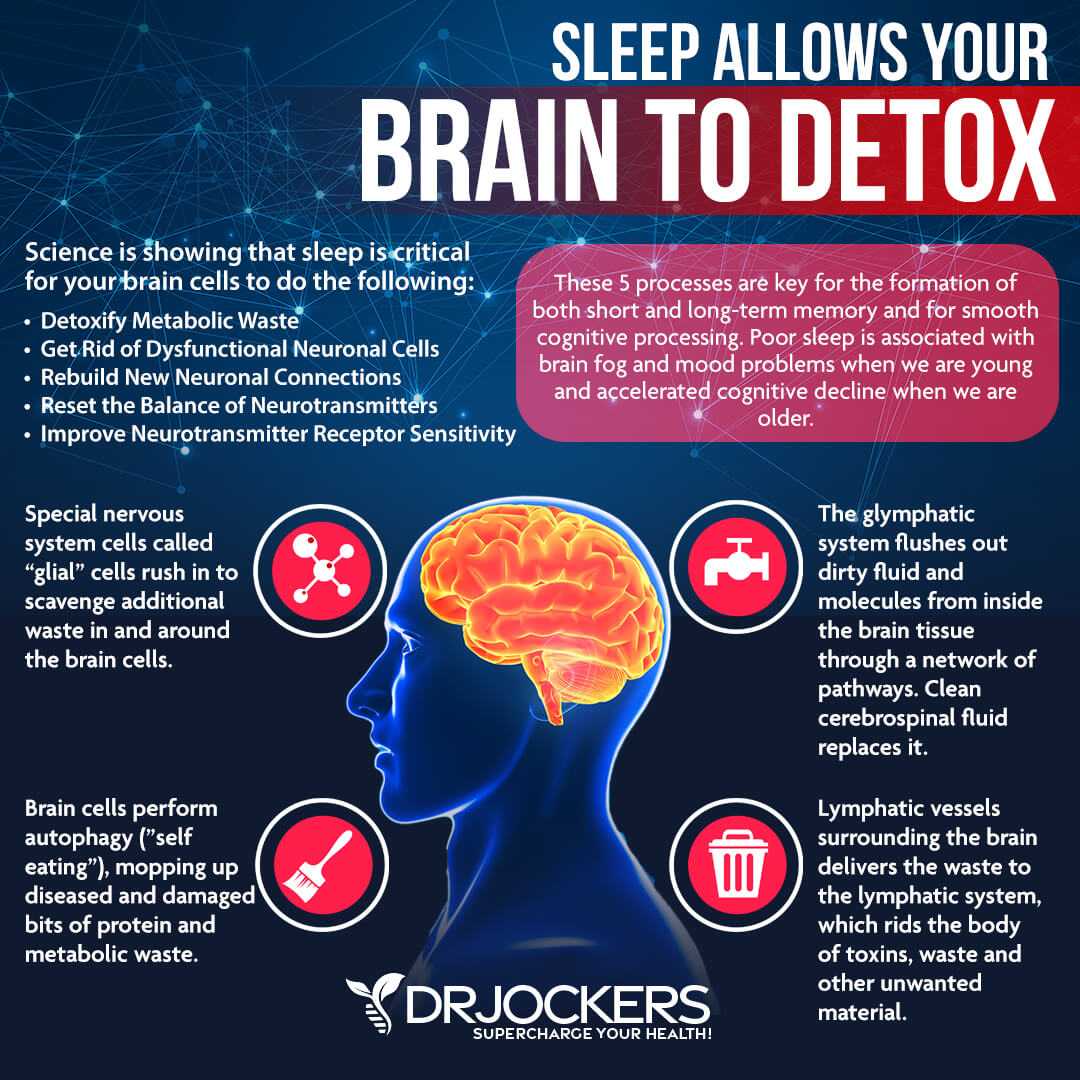
Common Food Triggers
Migraines are often triggered by certain foods or may be caused by sensitivity to a certain food. Eliminating common food triggers may help reduce or eliminate your migraines.
Common food triggers include:
- Gluten
- Dairy
- Eggs
- Soy
- Corn
- Sugar
- Chocolate
- Additives
- Preservatives
- Alcohol
- Caffeine

12 Natural Strategies to Support Migraines
If you have regular migraines, chances are you want them gone. I’m here to tell you that it is definitely possible to reduce or eliminate your migraine attacks naturally.
While these strategies are not all FDA-approved to prevent, mitigate, treat, or cure migraines they can be extremely helpful for reducing tension and improving circulation. Many of these strategies also address underlying nutrient deficiencies that may be catalysts to the development of migraines.

Icekap Migraine Cap
While prevention is key to stopping your migraines for good, I understand that immediate relief is important. Research has shown that a cooling ice pack can provide effective relief from a migraine attack. This is why I recommend the Icekap Migraine Cap to my patients and friends who are experiencing migraines (9).
If you have a migraine attack, the Icekap Migraine Cap can bring you immediate relief. It comes with therapy grade non-toxic gel ice packs that can be both heated and cooled depending on your needs. With the help of an adjustable occipital tension band, it creates a perfect compression for quick migraine relief to help you get back on your feet right away.
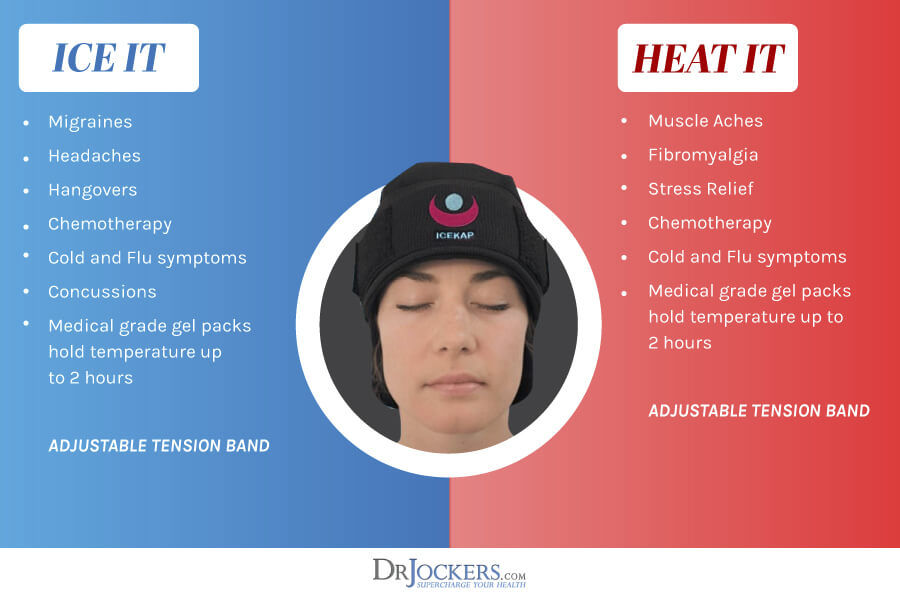
Anti-Inflammatory Diet
Chronic inflammation is the number one root cause of all chronic pain and disease. Chronic inflammation may be one of the main causes of your migraines as well. Eating an anti-inflammatory diet is essential to prevent migraines and improve your overall health.
Eliminate refined sugar, processed foods, refined oils, artificial ingredients, gluten, and other inflammatory foods. Eat a diet rich in organic greens, vegetables, low glycemic index fruits, nuts, seeds, high-quality grass-fed meat, free-range poultry, wild-caught fish, wild game, grass-fed butter and ghee, and free-range eggs.
Eat plenty of anti-inflammatory herbs and spices, such as turmeric, ginger, cinnamon, and rosemary. You may learn more about a healthy anti-inflammatory diet in this article, and my favorite anti-inflammatory herbs in this article.
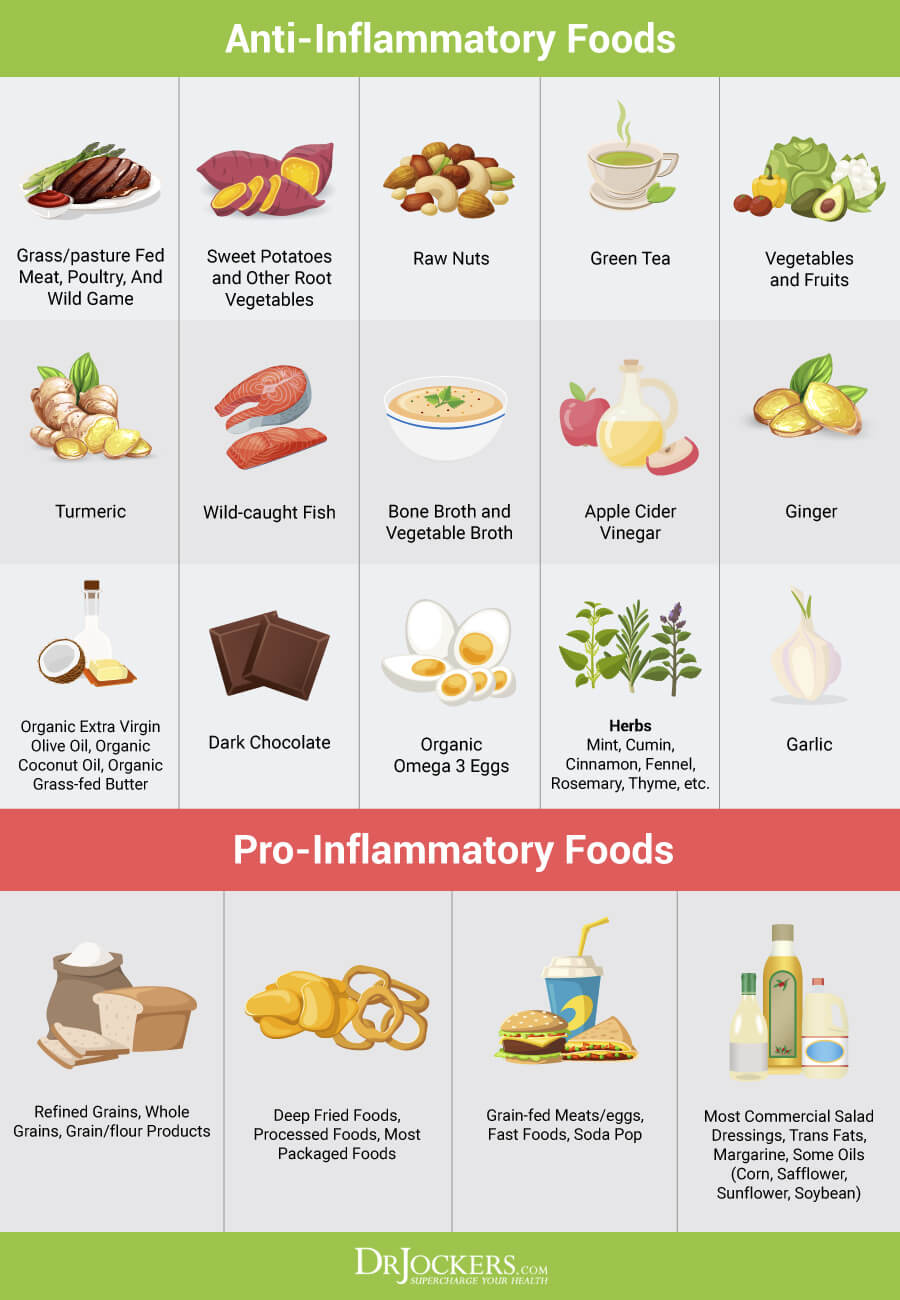
Prioritize Sleep
I cannot emphasize enough how important sleep is for your overall well-being. Sleep deprivation may have serious health consequences, and according to research, it may result in migraines and headaches.
According to a study comparing people who got less than six hours of sleep per night and people who slept more than six hours, those who slept less had more frequent and more severe migraines. Research has also shown that getting the right amount of sleep is essential for migraine prevention with seven to nine hours being the ideal amount per night (10, 11, 12).
Make sure to sleep seven to nine hours a night. Develop a regular sleeping schedule. Avoid eating close to bedtime. Develop a calming night-time routine that helps you to relax and get ready for a good night’s sleep. Read this article for more info on how to improve your sleep quality.

Deep Breathing Habits and Stress Management
A lack of oxygen at the cellular level can lead to a variety of health issues and pain, including migraines. Chronic stress is another serious contributing factor to inflammation, chronic pain, and chronic health problems. A lack of deep breathing habits and high-stress levels both can contribute to migraines (13, 14).
I recommend that you practice deep breathing exercises at least two to three times daily. You may learn more about deep breathing strategies in this article. It is also important that you decrease your stress levels, learn stress management strategies, and engage in stress-reducing, relaxing activities, such as meditation, journaling, yoga, time in nature, relaxing baths, and spending time with loved ones.
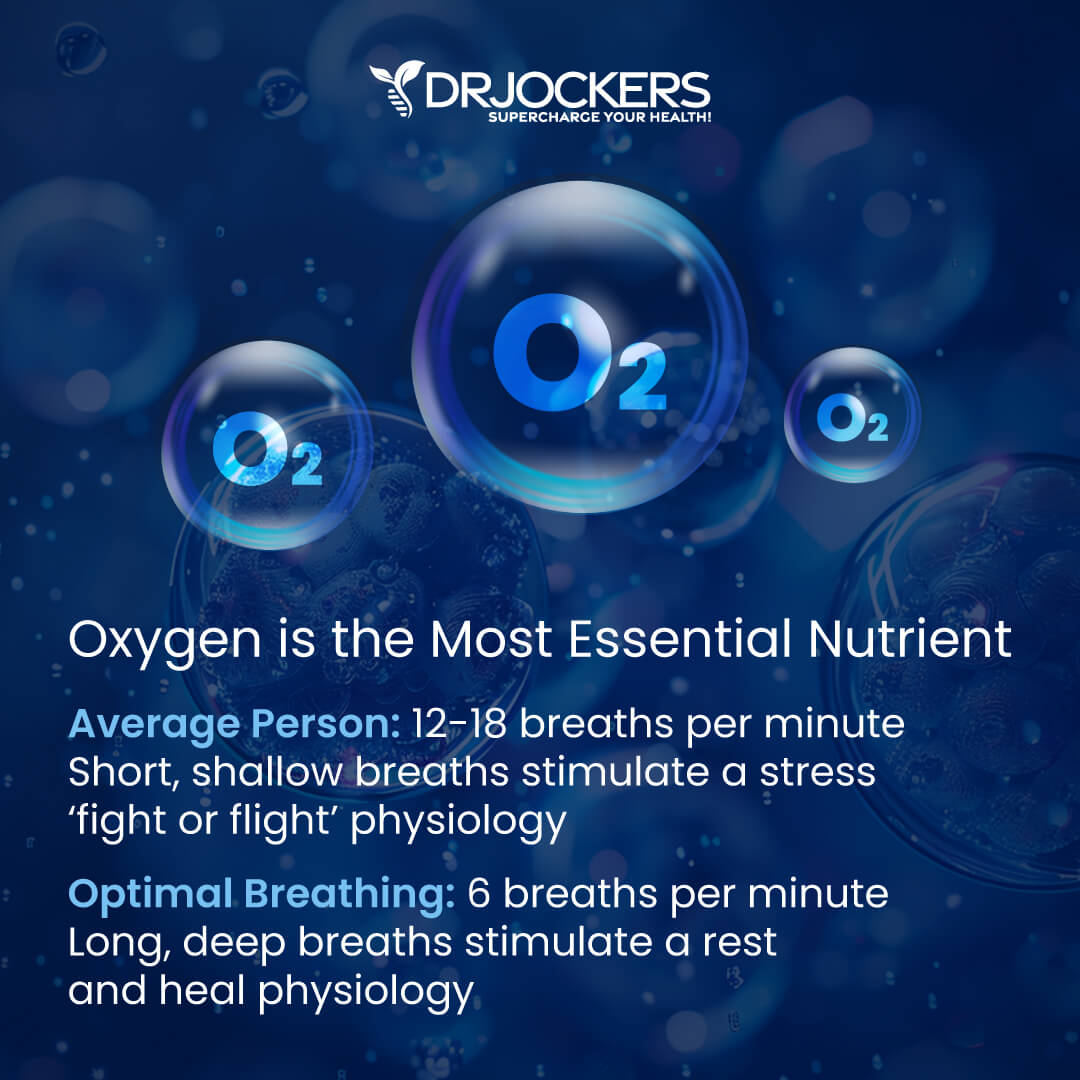
Improve Magnesium Levels
Magnesium has been linked to migraines and headaches. People with diabetes, heart disease, and alcoholism are particularly prone to low magnesium levels, however, due to our depleted soils, even those who are eating an otherwise healthy and nutrient-dense diet may be low on magnesium and can benefit from magnesium supplementation.
Eating foods rich in magnesium, such as high-quality meat, beans, nuts, seeds, leafy greens, broccoli, and squash may benefit you if you have migraines. However, as mentioned, food is often not enough. Research has shown that taking 200 to 600 mg of magnesium a day may reduce the frequency of migraine attacks (15).
I recommend regular magnesium-rich Epsom salt baths to increase your magnesium levels and calm your body at the same time. I also recommend taking a high-quality magnesium supplement daily to improve your magnesium levels and increase your overall health.

Chiropractic Care
You don’t have to ask me twice about the benefits of chiropractic care. It is a fantastic drug-free and surgery-free path to help your body heal and feel better naturally. Chiropractic care can reduce oxidative stress on your body, lower inflammation, and stop the pain. It can help you correct your posture naturally, which is important considering that bad posture may be one of the underlying causes of your migraines.
Research also indicates the benefits of chiropractic care and spinal manipulation of migraines and headaches. A chiropractic adjustment can stop your migraine attack in its tracks, and regular chiropractic care can reduce the frequency of your migraines or even eliminate them altogether. According to a qualitative literature review of nine studies on the benefits of chiropractic care on migraines and tension headaches, participants experienced good to excellent benefits and found chiropractic care to be a good treatment option (16).
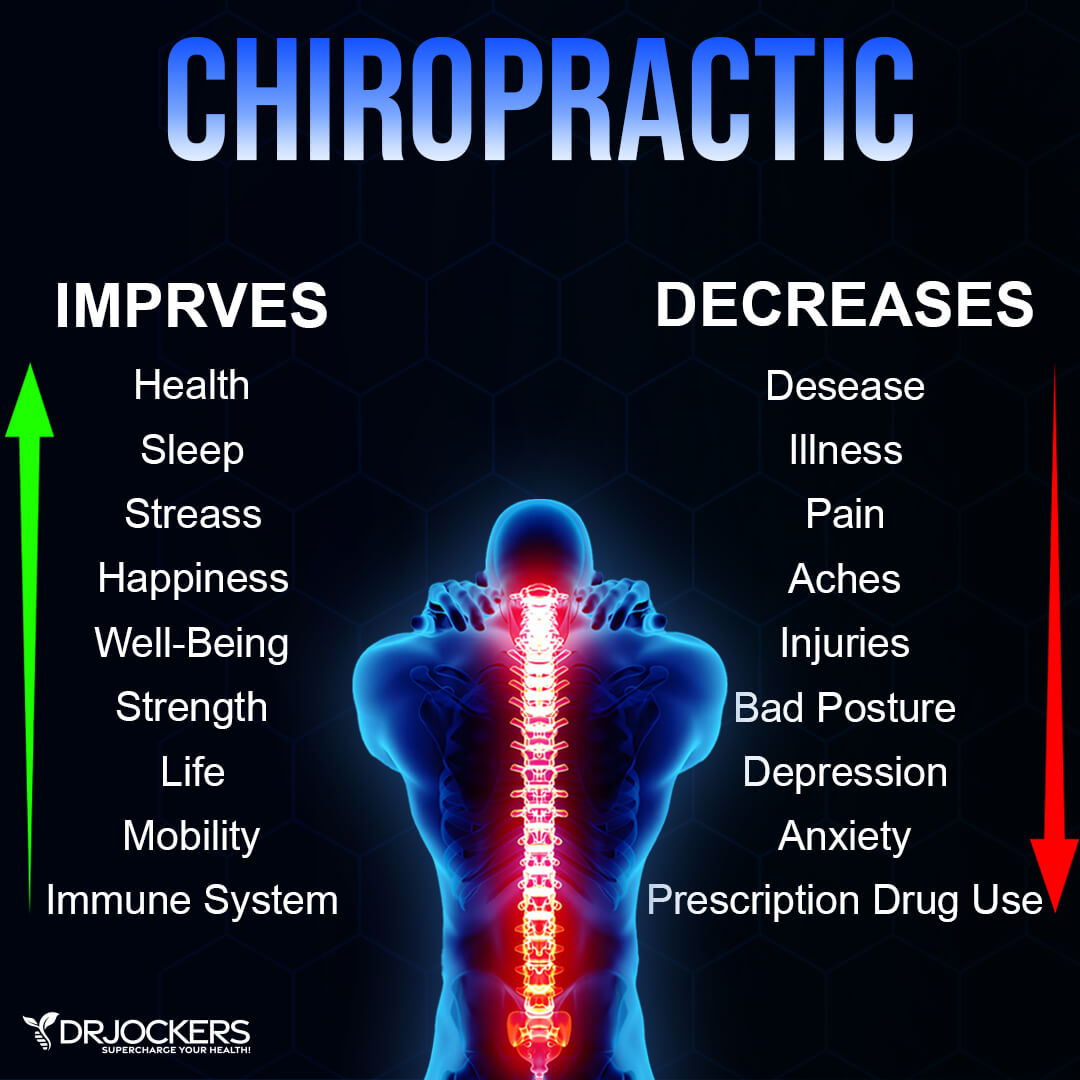
Optimize Hydration Levels
As you’ve learned earlier, dehydration may lead to migraines and other types of headaches. You may get dehydrated from not drinking enough water throughout the day. Coffee, sugary drinks, and alcohol can also have a dehydrating effect leaving you with a migraine (17).
It is important that you hydrate well. Drink 8 to 10 glasses of water a day, more if you exercise a lot or you stay out in the hot sun for a long time. Make sure to also eat hydrating vegetables and fruits as well, such as cucumbers, celery, green pepper, zucchini, cabbage, strawberries, raspberries, oranges, lemons, and grapefruit.

B Complex Supplements
Having adequate levels of B vitamins is incredibly important for your overall health. B vitamins are essential for the formation of neurotransmitters, such as serotonin, which are essential for a healthy brain, and deficiency of them may lead to migraines, headaches, brain fog, and fatigue.
A B vitamin complex includes eight water-soluble vitamins, thiamine, riboflavin, vitamin B6, folate, biotin, pantothenic acid, and vitamin B12, that work together to improve your brain cells, immune function, energy levels, circulation, and cardiovascular health. Research has linked both vitamin B2 and B3 to the reduction of migraine duration and frequency, calming headaches, and increasing blood flow. Research has also shown that taking a B12 complex for 12 weeks only may reduce stress levels and increase mood, both of which may be linked to migraines (18).
I highly recommend taking a powerful B vitamin complex. B vitamins can help improve your blood sugar, support cellular energy production, calm the nervous system, aid optimal circulation and blood pressure, reduce pain, help bone density and calcium balance, improve joint and ligament flexibility, help muscle relaxation, and better your sleep.
Look for one with pre-activated forms of B vitamins such as methyl-folate, methyl-cobalamin (B12), Pyridoxal-5-Phosphate form of B6, and Riboflavin-5-phosphate form of vitamin B2. The methyl groups are in the active form and will be better utilized by the body.

Sun Exposure and Vitamin D
Vitamin D deficiency is one of the most common deficiencies associated with multiple chronic conditions, including migraines, cardiovascular disease, osteoporosis, cancer, and diabetes. Optimal vitamin D levels are crucial for your health; however, it can be challenging to achieve them.
Most people spend too much time indoors or live in less sunny, cooler climates to receive all their vitamin D levels from the sun. Our soils are depleted, hence it is difficult to get enough vitamin D from our food, which makes supplementation necessary (19, 20, 21, 22, 23, 24, 25).
To achieve adequate levels of vitamin D, I recommend that you turn to a combination of sun exposure, foods rich in vitamin D, and supplements. Make sure to spend some time outside to get some sun exposure as long as the weather allows it.
Eat nutrient-dense foods high in vitamin D, such as salmon, fatty fish, egg yolk, chicken or beef liver, grass-fed butter, grass-fed raw cheese, and mushrooms. Make sure to choose organic, grass-fed, free-range, and wild-caught animal products.
You should also consider supplementing with vitamin D to get your levels up to the optimal range of 50-100 ng/ml. Typically supplementing with around 1,000 IU’s per 25 lbs of body weight will get you into that range, however, some people absorb vitamin D better than others and so it is important to test every 6 months or so to see where your levels are.
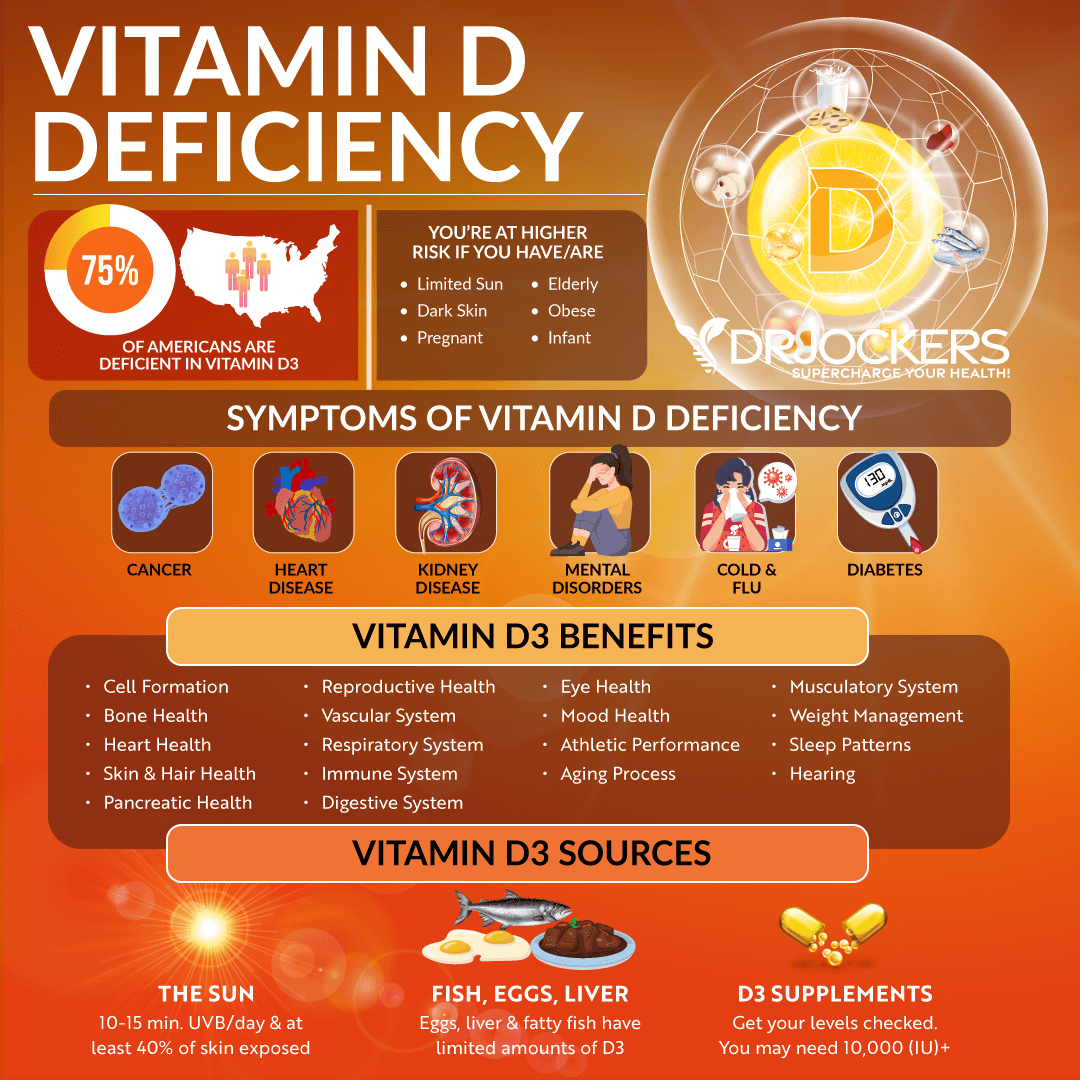
Diffuse Essential Oils
Diffusing essential oils may be a fantastic idea to experience migraine relief due to their calming and numbing effects. You may also use therapeutic grade essential oils on your skin by placing a few drops on your hands and rubbing them on your forehead. You may dilute it with coconut oil as well for extra moisturizing benefits.
My two favorite essential oils for migraines are peppermint and lavender oil. Research has shown that peppermint oil can increase skin blood flow and suit muscle contractions. It has a long-lasting cooling effect on the skin and a soothing effect when inhaled.
Lavender oil has a sedative, calming, and mood stabilizer effect. Research has shown that inhaling lavender oil for only 15 minutes may reduce symptoms of migraine effectively (26, 27).
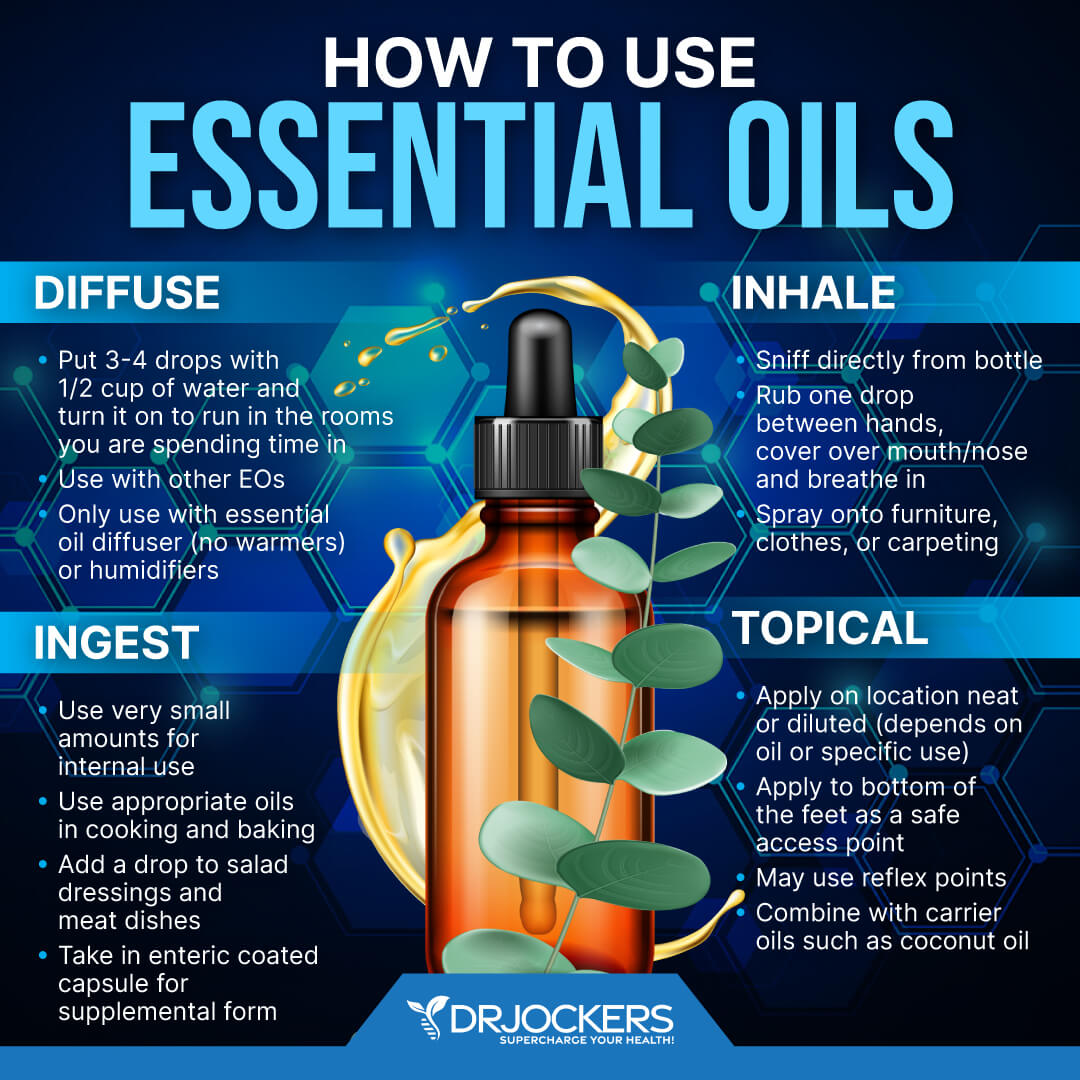
Natural Herbs
Using natural herbs may be a wonderful way to improve your health, lower inflammation, prevent migraine attacks, and reduce the symptoms of your migraines. There are four herbs I always recommend to my patients with migraines:
Lemon Balm
Lemon balm is a traditional European remedy that has been used for hundreds of years. It is fantastic for promoting relaxation; hence it may help to calm your nerves and improve your migraines (28).

Passionflower
Passionflower is a wonderful herb that may better your sleep, lower your blood pressure, decrease inflammation, reduce muscle tension, and lower anxiety. As a result, it may reduce your migraine symptoms (29).
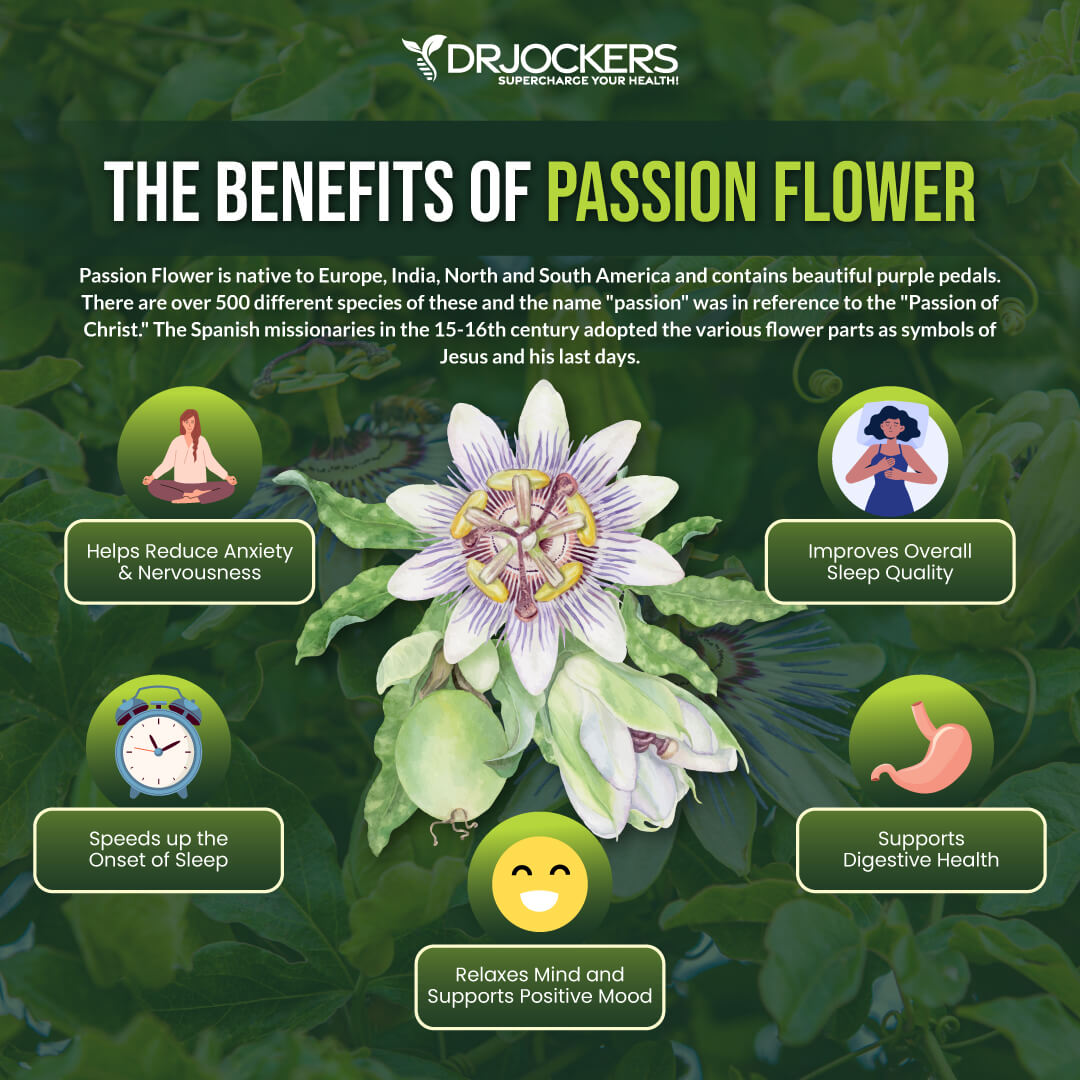
Valerian Root
Valerian root is a wonderful calming herb that can induce a state of relaxation, improve sleep, and lower anxiety. These benefits may also help you to reduce your migraine symptoms and the frequency of your migraine attacks (30)
Skullcap
Skullcap is a powerful herb in the mint family. Due to its calming and sedative benefits, it may also reduce your migraine symptoms (31).
We offer many of these herbs including skullcap, valerian, passionflower and lemon balm along with calcium and magnesium in our Relax Calm product here.
Use CBD Oil
Cannabidiol, or CBD oil, is a non-psychoactive cannabinoid found in cannabis that has become one of the most popular supplements for pain relief and other health benefits in recent years. One of its main benefits is providing relief for migraines.
The cannabis plant has been used for its pain-reducing benefits since 2900 BC. Today, increasing research is backing up the health benefits of the plant. CBD oil is a fantastic way to experience the benefits of the cannabis plant without ‘getting high’. You may learn more about the benefits of CBD oil in this article.

Final Thoughts on Migraines
Migraines are not just a headache. They are severe throbbing or pulsating pain that may be accompanied by nausea, vomiting, sensitivity to smell or sound, and an aura. They affect 1 billion people worldwide.
If you are someone who is experiencing migraines, try my top 12 natural support strategies to help improve your overall circulation, reduce tension, and improve your inflammatory response. For many, they find that just applying a handful of these strategies can make a big difference in their quality of life.
If you want to work with a functional health coach, I recommend this article with tips on how to find a great coach. We offer long-distance functional health coaching programs with our world class team. For further support with your health goals, just reach out and our fantastic coaches are here to support your journey.

Inflammation Crushing Ebundle
The Inflammation Crushing Ebundle is designed to help you improve your brain, liver, immune system and discover the healing strategies, foods and recipes to burn fat, reduce inflammation and Thrive in Life!
As a doctor of natural medicine, I have spent the past 20 years studying the best healing strategies and worked with hundreds of coaching clients, helping them overcome chronic health conditions and optimize their overall health.
In our Inflammation Crushing Ebundle, I have put together my very best strategies to reduce inflammation and optimize your healing potential. Take a look at what you will get inside these valuable guides below!
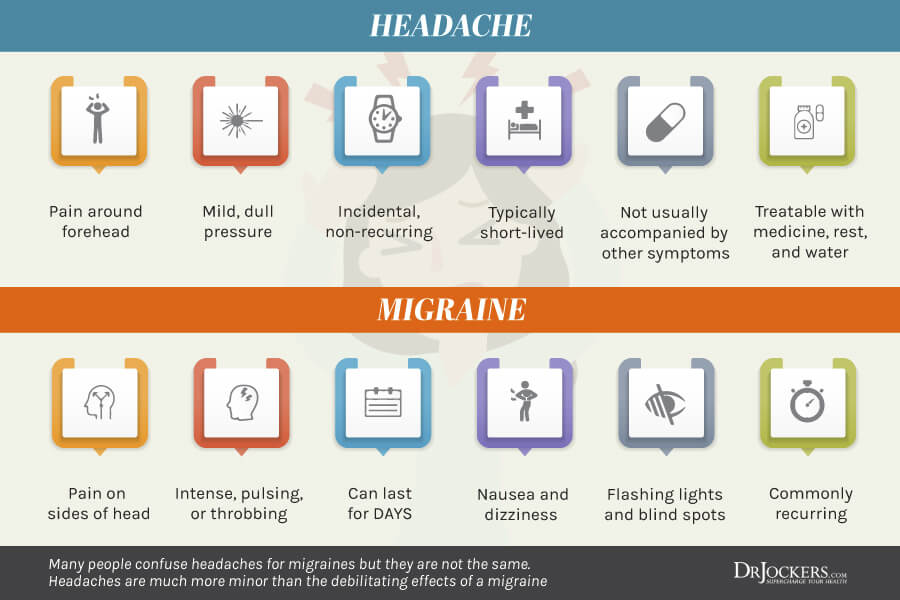





What form of magnesium would you recommend one take to help with migraines?
Thank you!
Yes I would do magnesium L-threonate which is the best for headaches. https://store.drjockers.com/products/brain-calm-magnesium